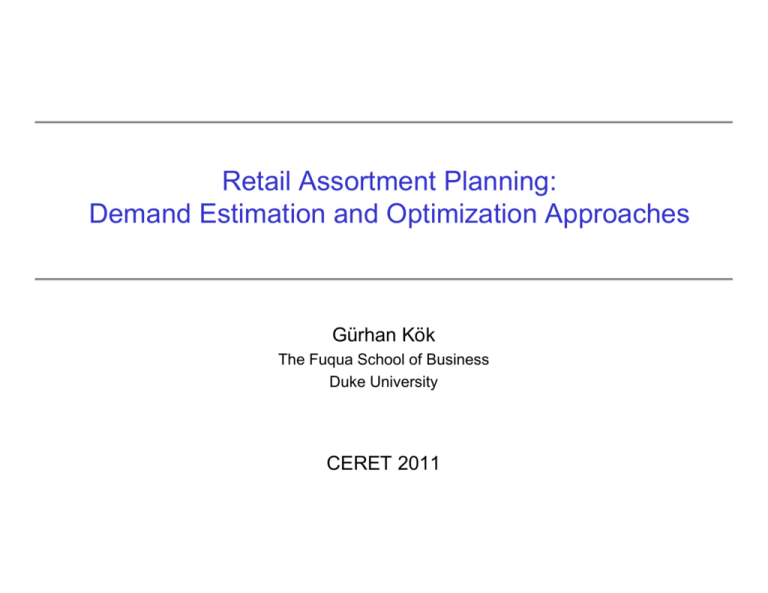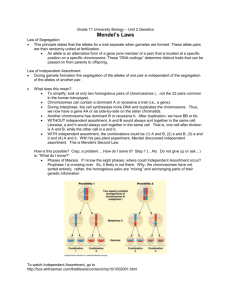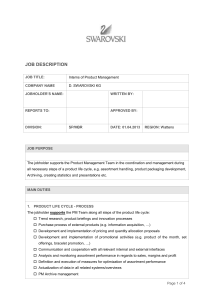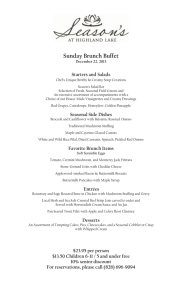Retail Assortment Planning
advertisement

Retail Assortment Planning:
Demand Estimation and Optimization Approaches
Gürhan Kök
The Fuqua School of Business
Duke University
CERET 2011
Outline
Industry Approach
Best Buy
Borders
Albert Heijn (Ahold)
Tanishq, India
(Kok and Fisher and Vaidyanathan, 2008, Book chapter)
Academic Approach
Kok and Fisher, 2007, Operations Research
Fisher and Vaidyanathan, 2007, Working paper
Kok and Xu
Xu, 2011
2011, Management Science
Bernstein, Kok, and Xie, 2010, Working paper
Gurhan Kok, Retail Assortment Planning
2
Definition of an Assortment
Category examples
Men’s dress shirts, Sunglasses, DVD players, Cereals
Assortment at category level
Breadth: Number of categories
g
Depth: “size of assortment” in each category
Assortment at product level
A selection of product variants within a category
Products are differentiated by some attributes
Products are potential substitutes
Number of SKUs or facings is limited by category shelf space
Gurhan Kok, Retail Assortment Planning
3
Assortment Planning at Best Buy
Hierarchical planning
Focus on buying at chain level
Deployment
p y
to stores ((based on store clusters, climate zone etc.))
Dynamic environment
Identifying growth opportunities (digital vs. traditional camera)
New products
Short life cycle (Newsvendor kind of addresses that)
Markdown pricing
Not every category is the same
Identifying critical resources (Promo, labor, impulse, price,
selection)
se
ect o ) for
o d
different
e e t catego
categories
es
Gurhan Kok, Retail Assortment Planning
4
Critical to Align Assortment with Company Strategy…
Primary Attribute
Price
Service
Product
Experience
Access
Seccondary Attribu
ute
Price
Service
Product
Experience
p
Access
Gurhan Kok, Retail Assortment Planning
5
…and Allocate Resources based on Marginal Returns
Category
Promo
Labor
Impulse
Price
Selection
Computer
High
High
Low
High
Medium
Refrigerator
Medium
High
Low
Medium
High
Accessories Low
Low
High
Low
Low
Movies
Med
High
High
High
High
Gurhan Kok, Retail Assortment Planning
6
Identify Growth Opportunities
Gurhan Kok, Retail Assortment Planning
7
Assortment Localization
Gurhan Kok, Retail Assortment Planning
8
Assortment Planning at Borders
Basic Premise – “Except for best sellers, customer is interested
NOT in title BUT category”
300 000 titles grouped into 300 categories
300,000
Category popularity assessed by computing Relative Sales Per Title
Category Sales
RST
No. of Titles
Shelf space periodically reassigned from low RST to high RST
Following the principle of Darwin’s
Darwin s “Natural
Natural Selection
Selection” and “Survival
Survival
of the Fittest”, categories “fight” for shelf space
Store managers allowed to pick titles to be stocked within each
category thereby decentralizing a part of the decision process
category,
Gurhan Kok, Retail Assortment Planning
9
Shelf Space Allocation at Albert Heijn
Frank Jensen’s method
Category 1
Category sales curves are
estimated by using data
from multiple stores
Gross Pro
ofit
Category 2
Category 3
Metric shelf space allocated to category j
For each store: Allocate meters of space with Greedy method until
the store runs out of space
Gurhan Kok, Retail Assortment Planning
10
Assortment Planning at Tanishq
No.1 Jewelry retailer in India
30,000 SKUs, 15 categories, 52 retail outlets
Di erse demand patterns across stores
Diverse
Assortment planning decisions are
Hierarchical at higher attribute levels (category, theme, design)
Decentralized for lower attribute levels (models, size), to provide
for local customization of stock mix
For example, each store to carry 30% of national best sellers,
20% of regional best sellers, 10% of store best sellers, and rest
decided at store level
Gurhan Kok, Retail Assortment Planning
11
12
Localized Assortment Research at Albert Heijn
Kok and Fisher (2007)
Consumer Response to Unavailability of a Product
Gurhan Kok, Retail Assortment Planning
14
Substitution
Sales response to more choices depends on substitution %
100% substitution
Sales
50% substitution
0% substitution
1 2 3 4 ….
Number of items available to consumer on g
given day.
y
Assume items have equal demand
Gurhan Kok, Retail Assortment Planning
15
Local Assortment Research with Albert Heijn
nj = number of facings assigned to SKU j.
wj = width of a facing for SKU j
Max jGPj(nj)
profit of
Gross p
product j with facing
assignment nj
s.t. j wj nj ≤ Available Shelf Space
nj ≥ 0 and integral
Deployment challenges
Estimating demand for SKUs not currently carried in the store
Substitution
Impact of stock outs on product gross profit
Maximizing j GPj(n) given interconnectedness – stock out of product
A increases demand for B
Gurhan Kok, Retail Assortment Planning
16
Local Assortment Optimization
GP increase with
more facings
g due to
increased inventory
(lower lost sales
SKU 1
Gross Proffit
G
SKU 2
SKU 3
Number of facings allocated to
each SKU (inventory level)
KEY TRADEOFF:
Breadth (number of items) vs Service Levels (max InventoryLevels)
Gurhan Kok, Retail Assortment Planning
17
Substitution Matrix Examples
Gurhan Kok, Retail Assortment Planning
18
Estimating Assortment-Based Substitution:
Carried in store
Not carried
Observed
demand
D1
D2
D3 ..
..
..
Dk
0
dk
dk+1
..
..
0
Estimate using store
specific models
Substitution
T
True
demand
d
d
d1
d2
d3 ..
..
..
..
Substitution probability from product i to j: ij
..
Estimate using
national models on
full assortment stores
dj
d
lN {i}
Gurhan Kok, Retail Assortment Planning
dJ
l
19
Observed Demand vs. Full Assortment Demand
9
observed demand
8
full assortment demand
demand
d rate
7
6
5
4
3
2
1
80
75
7
12
85
3
84
30
6
51
84
28
59
27
6
92
84
5
63
77
1
84
30
5
50
61
26
0
When a store
carries less than full
assortment,
observed demands
are higher than full
assortment demand
due to substitution
SKUs @ store 1161 (segm ent 3 - deepfry)
Gurhan Kok, Retail Assortment Planning
20
Estimated Substitution Rates
segments
1
2
3
4
5
6
7
8
9
10
11
12
SR
Week = 91
Error reduction
0.3
0
3
0%
0.1
0%
1
1%
0.9
34%
0.6
38%
0.9
33%
1
20%
0.1
0%
0.8
0%
1
29%
1
5%
1
36%
Gurhan Kok, Retail Assortment Planning
SR
Week = 38
Error reduction
0
0%
0.3
0%
1
1%
0.8
30%
0.5
31%
0.7
24%
1
19%
0
0%
0.8
0%
1
30%
1
7%
1
35%
21
Results: Impact on Gross Profit
Gurhan Kok, Retail Assortment Planning
22
Impact of Substitution
Gurhan Kok, Retail Assortment Planning
23
Sources of Improvement: Example
Gurhan Kok, Retail Assortment Planning
24
More Improvement When Shelf Space is Tight
group 3
25%
group 55
Li
Linear
((group 55)
% improvement
20%
Linear (group 3)
15%
10%
R2 = 0.1304
5%
R2 = 0.5117
0%
0
5000
10000
15000
20000
25000
30000
35000
Shelf space (m ore space corresponds to larger stores)
Gurhan Kok, Retail Assortment Planning
25
Attribute-Based Substitution Estimation
Vaidyanathan and Fisher (2007)
Identify Relevant Product Attributes
sub-category
thread count
fabric
price
color
l
size
weave
Attribute-based view is useful for
Understanding substitution behavior
Choosing localization objectives
Estimating demand for new products (Fader and Hardie 1996)
Gurhan Kok, Retail Assortment Planning
27
Snack Cakes:
Estimate Sales Potential of all SKUs and Substitution Rates
Gurhan Kok, Retail Assortment Planning
28
Snack Cakes: Estimated Substitution Rates
Gurhan Kok, Retail Assortment Planning
29
Assortment Changes for one Store
Gurhan Kok, Retail Assortment Planning
30
Tires: Sales Data from one Store
Gurhan Kok, Retail Assortment Planning
31
Tires: Substitution Estimates
Gurhan Kok, Retail Assortment Planning
32
Impact of Localization
6%
32%
Current
assortment
Gurhan Kok, Retail Assortment Planning
33
Hierarchical Choice Models
Kok and Xu (2011)
Subgroups Based on Product Type
Gurhan Kok, Retail Assortment Planning
35
Subgroups Based on Brand
Gurhan Kok, Retail Assortment Planning
36
Assortment Planning and Pricing Regimes
Pepsi Brand
Manager
Coke Brand
Manager
Category
Manager
Gurhan Kok, Retail Assortment Planning
37
Brand-Primary Model vs. Type-Primary Model
Product types are not
functionally differentiated or
brand loyalty is strong
Dress shirts with different colors
Ice creams with different flavors
Detergents with different scents
Product types
yp are functionally
y
differentiated
Regular vs. diet drinks,
Regular vs. decaf coffee,
Sedan vs. mini-van,
Point-and-shoot vs. SLR camera
(Kannan and Wright 1991, Urban et al. 1984, Grover and Dillon 1985, Allenby 1989)
Gurhan Kok, Retail Assortment Planning
38
Type-Primary Model: Centralized Management
Product types
1
2
Brand X
X
X
Brand Y
Y
Y
3
4
5
6
7
6
7
X
Y
Y
Can be optimal
1
2
Brand X
X
X
Brand Y
Y
Y
3
Y
4
5
X
X
Y
Y
Cannot be optimal
Gurhan Kok, Retail Assortment Planning
39
Dynamic Assortment Customization
in Online Retailing
Bernstein, Kok and Xie (2011)
Example: Online Retailer
Gurhan Kok, Retail Assortment Planning
41
Example: Online Retailer
Gurhan Kok, Retail Assortment Planning
42
Example: Online Retailer
Gurhan Kok, Retail Assortment Planning
43
Characterizing the Policy
y*1(y2)
y1*(y2)
y*2(y1)
y2*(y1)
10
Product 1
9 not
8 offered to
segment 2
7
Full assortment
offered to all
segments
y2 6
5
4
3
Product 2 not
offered to
segment 1
2
1
0
0
1
2
3
4
5
6
7
8
9
10
y1
Gurhan Kok, Retail Assortment Planning
44
Broader Questions on Customization
Customer behavior
p
of sort order on p
purchasing
g behavior
Impact
Can we refine estimates based on clicks during a search?
Revenue maximization and demand management
Customization
C t i ti b
based
d on customer
t
characteristics
h
t i ti
Customization based on margins
y levels or supply
pp y outlook
Customization based on inventory
Gurhan Kok, Retail Assortment Planning
45
Thank you!
Papers are available at my web site.
site
http://faculty.fuqua.duke.edu/~agkok/
Pl
Please
send
d comments
t and
d stories
t i tto
gurhan.kok@duke.edu
Gurhan Kok, Retail Assortment Planning
46







